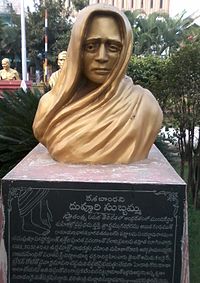Duvvuri Subbamma
Duvvuri Subbamma (15 November 1881 – 31 May 1964) was an Indian independence activist who played an important role in the Indian independence movement. She was one of the founders of the women's congress committee.[1]
Duvvuri Subbamma | |
|---|---|
 Memorial to Duvvuri Subbamma in the Freedom Park in Rajahmundry, India | |
| Born | 15 November 1881 Daksharamam, East Godavari district, Andhra Pradesh, India |
| Died | 31 May 1964 (aged 82) |
| Nationality | Indian |
BiographyEdit
Subbamma was born in 1880 in Daksharamam, East Godavari district, Andhra Pradesh.[1] A child bride, she was married at the age of ten.[1] She was widowed at a very young age. After her husband's death, she took up activism and joined the Quit India Movement against the British Raj.[1][2] She took part in the civil disobedience movement and strongly advocated total freedom from British rule in India.
In 1922 she organized the women's congress committee.[3] In 1923 she organized a meeting in Kakinada, Andhra Pradesh, where hundreds of women volunteers attended the Kakinada Congress Mahasabha.[3] Subbamma organized Andhra Mahila Sabhas that trained and educated women in the national freedom movement and was instrumental in galvanizing support of the women in the Indian independence movement. She extensively traveled throughout Andhra Pradesh promoting women's empowerment.[3]
Together with other activists like Nadimpalli, Sundaramma helped set up the Goteti Manikyamba, Andhra Mahasabha, and T. Varakshmamma organizations. Subbamma was arrested and incarcerated in the Rajahmundry prison for one year due to her activities on behalf of the civil disobedience movement. She also spent a year in the Rayavellore prison for taking part in the Salt March.[4] She aggressively spoke out and worked for the abolition of untouchability in India.[3]
She is memorialized with a bust in the Freedom Park in Rajahmundry.[5]
ReferencesEdit
- ↑ 1.0 1.1 1.2 1.3 Basu, Amrita; Editor, Amrita Basu (2011). Women's Movements in the Global Era. Read How You Want. ISBN 9781458781826.
{{cite book}}:|last2=has generic name (help) - ↑ Thakur, Bharti (2006). Women in Gandhi's Mass Movements. Deep & Deep Publications. ISBN 9788176298186.
- ↑ 3.0 3.1 3.2 3.3 Ray, Bharati (15 September 2005). Women of India: Colonial and Post-colonial Periods. SAGE Publications India. ISBN 9788132102649.
- ↑ Naidu, Ch M. (1 January 1986). Salt Satyagraha in the Coastal Andhra. Mittal Publications.
- ↑ "Unsung and unhonoured". The Hans India. 15 August 2017. Retrieved 3 December 2017.